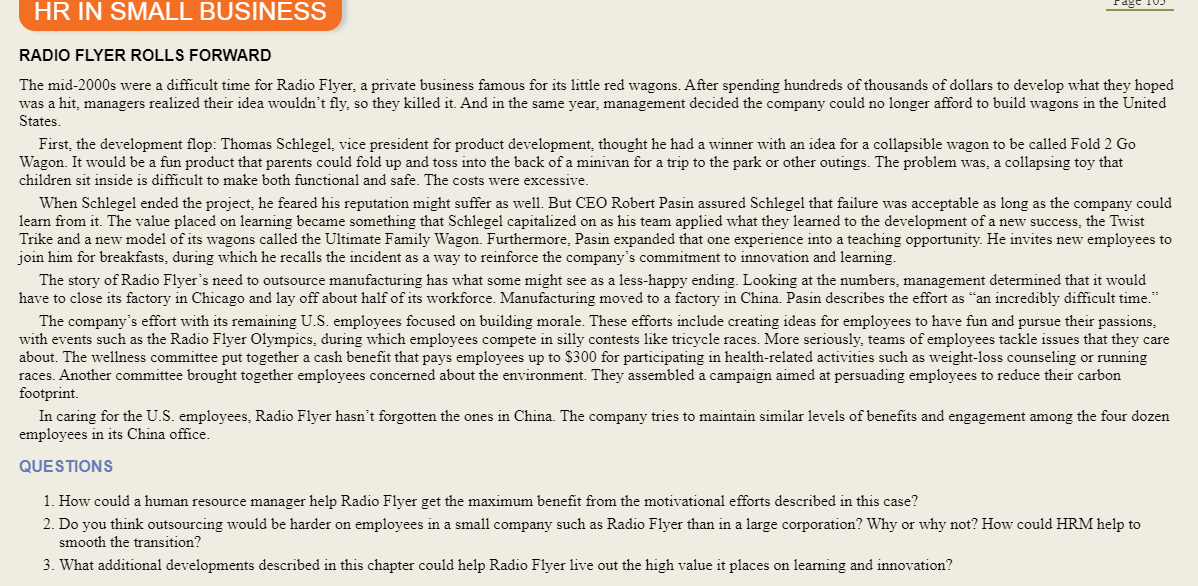QUESTIONS 1. How could a human resource manager help Radio Flyer get the maximum benefit from the motivational efforts described in this case?
QUESTIONS 1. How could a human resource manager help Radio Flyer get the maximum benefit from the motivational efforts described in this case?
Management, Loose-Leaf Version
13th Edition
ISBN:9781305969308
Author:Richard L. Daft
Publisher:Richard L. Daft
Chapter12: Managing Human Talent
Section: Chapter Questions
Problem 1EE
Related questions
Question
Answer the questions below

Transcribed Image Text:HR IN SMALL BUSINESS
RADIO FLYER ROLLS FORWARD
The mid-2000s were a difficult time for Radio Flyer, a private business famous for its little red wagons. After spending hundreds of thousands of dollars to develop what they hoped
was a hit, managers realized their idea wouldn't fly, so they killed it. And in the same year, management decided the company could no longer afford to build wagons in the United
States.
First, the development flop: Thomas Schlegel, vice president for product development, thought he had a winner with an idea for a collapsible wagon to be called Fold 2 Go
Wagon. It would be a fun product that parents could fold up and toss into the back of a minivan for a trip to the park or other outings. The problem was, a collapsing toy that
children sit inside is difficult to make both functional and safe. The costs were excessive.
When Schlegel ended the project, he feared his reputation might suffer as well. But CEO Robert Pasin assured Schlegel that failure was acceptable as long as the company could
learn from it. The value placed on learning became something that Schlegel capitalized on as his team applied what they learned to the development of a new success, the Twist
Trike and a new model of its wagons called the Ultimate Family Wagon. Furthermore, Pasin expanded that one experience into a teaching opportunity. He invites new employees to
join him for breakfasts, during which he recalls the incident as a way to reinforce the company's commitment to innovation and learning.
The story of Radio Flyer's need to outsource manufacturing has what some might see as a less-happy ending. Looking at the numbers, management determined that it would
have to close its factory in Chicago and lay off about half of its workforce. Manufacturing moved to a factory in China. Pasin describes the effort as "an incredibly difficult time."
The company's effort with its remaining U.S. employees focused on building morale. These efforts include creating ideas for employees to have fun and pursue their passions,
with events such as the Radio Flyer Olympics, during which employees compete in silly contests like tricycle races. More seriously, teams of employees tackle issues that they care
about. The wellness committee put together a cash benefit that pays employees up to $300 for participating in health-related activities such as weight-loss counseling or running
races. Another committee brought together employees concerned about the environment. They assembled a campaign aimed at persuading employees to reduce their carbon
footprint.
In caring for the U.S. employees, Radio Flyer hasn't forgotten the ones in China. The company tries to maintain similar levels of benefits and engagement among the four dozen
employees in its China office.
QUESTIONS
1. How could a human resource manager help Radio Flyer get the maximum benefit from the motivational efforts described in this case?
2. Do you think outsourcing would be harder on employees in a small company such as Radio Flyer than in a large corporation? Why or why not? How could HRM help to
smooth the transition?
3. What additional developments described in this chapter could help Radio Flyer live out the high value it places on learning and innovation?
Expert Solution
This question has been solved!
Explore an expertly crafted, step-by-step solution for a thorough understanding of key concepts.
This is a popular solution!
Trending now
This is a popular solution!
Step by step
Solved in 2 steps

Knowledge Booster
Learn more about
Need a deep-dive on the concept behind this application? Look no further. Learn more about this topic, management and related others by exploring similar questions and additional content below.Recommended textbooks for you

Management, Loose-Leaf Version
Management
ISBN:
9781305969308
Author:
Richard L. Daft
Publisher:
South-Western College Pub

Management, Loose-Leaf Version
Management
ISBN:
9781305969308
Author:
Richard L. Daft
Publisher:
South-Western College Pub